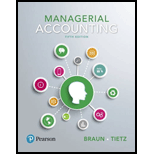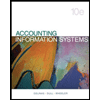
Managerial Accounting (5th Edition)
5th Edition
ISBN: 9780134128528
Author: Karen W. Braun, Wendy M. Tietz
Publisher: PEARSON
expand_more
expand_more
format_list_bulleted
Textbook Question
Chapter 1, Problem 9QC
(Learning Objective 5) Which of the following is false?
- a. Globalization has increased the necessity for more detailed and accurate cost information.
- b. The triple bottom line focuses on three items: net income, net assets, and
return on investment . - c. ERP systems integrate information from all company functions into a centralized data warehouse.
- d. Lean operations is a philosophy and business strategy of operating without waste.
Expert Solution & Answer
Want to see the full answer?
Check out a sample textbook solution
Students have asked these similar questions
What is the gross margin percentage of this financial accounting question?
managerial accoun
What will be the amount of depreciation recognized in 2023 on these financial accounting question?
Chapter 1 Solutions
Managerial Accounting (5th Edition)
Ch. 1 - (Learning Objective 1) Which of the following...Ch. 1 - (Learning Objective 2) Managerial accounting...Ch. 1 - (Learning Objective 3) Which of the following...Ch. 1 - (Learning Objective 3) Of the following skills,...Ch. 1 - (Learning Objective 4) Which of the following...Ch. 1 - Prob. 6QCCh. 1 - Prob. 7QCCh. 1 - Prob. 8QCCh. 1 - (Learning Objective 5) Which of the following is...Ch. 1 - (Learning Objective 5) All of the following are...
Ch. 1 - Managers responsibilities (Learning Objective 1)...Ch. 1 - Contrast managerial and financial accounting...Ch. 1 - Prob. 1.3SECh. 1 - Prob. 1.4SECh. 1 - Prob. 1.5SECh. 1 - Prob. 1.6SECh. 1 - Violations of ethical standards (Learning...Ch. 1 - Identify current competitive tools (Learning...Ch. 1 - Identify ethical standards violated (Learning...Ch. 1 - Define key terms (Learning Objectives 1, 2, 3, 4,...Ch. 1 - Define key terms (Learning Objectives 1 2)...Ch. 1 - Prob. 1.12AECh. 1 - Identify users of accounting information (Learning...Ch. 1 - Classify ethical responsibilities (Learning...Ch. 1 - Equipment purchase cost-benefit analysis (Learning...Ch. 1 - Lean production cost-benefit analysis (Learning...Ch. 1 - Identify sustainability efforts as impacting...Ch. 1 - Prob. 1.18BECh. 1 - Prob. 1.19BECh. 1 - Identify users of accounting information (Learning...Ch. 1 - Classify ethical responsibilities (Learning...Ch. 1 - Equipment purchase cost-benefit analysis (Learning...Ch. 1 - Lean production cost-benefit analysis (Learning...Ch. 1 - Prob. 1.24BECh. 1 - Management processes and accounting information...Ch. 1 - Ethical dilemmas (Learning Objective 4) Barb Perot...Ch. 1 - ERP cost-benefit analysis (Learning Objective 5)...Ch. 1 - Online order system cost-benefit analysis...Ch. 1 - Continuation of P1-28A: revised estimates...Ch. 1 - Management processes and accounting information...Ch. 1 - Ethical dilemmas (Learning Objective 4) ETHICS...Ch. 1 - ERP cost-benefit analysis (Learning Objective 5)...Ch. 1 - Online order system cost-benefit analysis...Ch. 1 - Continuation of P1-33B: revised estimates...Ch. 1 - Discuss how managerial accounting can be used at...Ch. 1 - Discussion Questions 1. What are the three main...Ch. 1 - Prob. 1.37ACTCh. 1 - Prob. 1.38ACTCh. 1 - Ethics and casual conversations (Learning...Ch. 1 - Using managerial accounting information to manage...
Knowledge Booster
Learn more about
Need a deep-dive on the concept behind this application? Look no further. Learn more about this topic, accounting and related others by exploring similar questions and additional content below.Similar questions
arrow_back_ios
SEE MORE QUESTIONS
arrow_forward_ios
Recommended textbooks for you
- Principles of Accounting Volume 2AccountingISBN:9781947172609Author:OpenStaxPublisher:OpenStax College
 Financial And Managerial AccountingAccountingISBN:9781337902663Author:WARREN, Carl S.Publisher:Cengage Learning,
Financial And Managerial AccountingAccountingISBN:9781337902663Author:WARREN, Carl S.Publisher:Cengage Learning, Managerial AccountingAccountingISBN:9781337912020Author:Carl Warren, Ph.d. Cma William B. TaylerPublisher:South-Western College Pub
Managerial AccountingAccountingISBN:9781337912020Author:Carl Warren, Ph.d. Cma William B. TaylerPublisher:South-Western College Pub  Cornerstones of Cost Management (Cornerstones Ser...AccountingISBN:9781305970663Author:Don R. Hansen, Maryanne M. MowenPublisher:Cengage Learning
Cornerstones of Cost Management (Cornerstones Ser...AccountingISBN:9781305970663Author:Don R. Hansen, Maryanne M. MowenPublisher:Cengage Learning Pkg Acc Infor Systems MS VISIO CDFinanceISBN:9781133935940Author:Ulric J. GelinasPublisher:CENGAGE L
Pkg Acc Infor Systems MS VISIO CDFinanceISBN:9781133935940Author:Ulric J. GelinasPublisher:CENGAGE L Managerial Accounting: The Cornerstone of Busines...AccountingISBN:9781337115773Author:Maryanne M. Mowen, Don R. Hansen, Dan L. HeitgerPublisher:Cengage Learning
Managerial Accounting: The Cornerstone of Busines...AccountingISBN:9781337115773Author:Maryanne M. Mowen, Don R. Hansen, Dan L. HeitgerPublisher:Cengage Learning

Principles of Accounting Volume 2
Accounting
ISBN:9781947172609
Author:OpenStax
Publisher:OpenStax College

Financial And Managerial Accounting
Accounting
ISBN:9781337902663
Author:WARREN, Carl S.
Publisher:Cengage Learning,

Managerial Accounting
Accounting
ISBN:9781337912020
Author:Carl Warren, Ph.d. Cma William B. Tayler
Publisher:South-Western College Pub

Cornerstones of Cost Management (Cornerstones Ser...
Accounting
ISBN:9781305970663
Author:Don R. Hansen, Maryanne M. Mowen
Publisher:Cengage Learning

Pkg Acc Infor Systems MS VISIO CD
Finance
ISBN:9781133935940
Author:Ulric J. Gelinas
Publisher:CENGAGE L

Managerial Accounting: The Cornerstone of Busines...
Accounting
ISBN:9781337115773
Author:Maryanne M. Mowen, Don R. Hansen, Dan L. Heitger
Publisher:Cengage Learning
Elements of cost | Direct and Indirect: Material, Labor, & Expenses; Author: Educationleaves;https://www.youtube.com/watch?v=UFBaj6AHjHQ;License: Standard youtube license